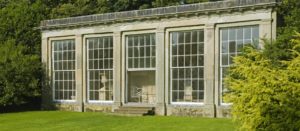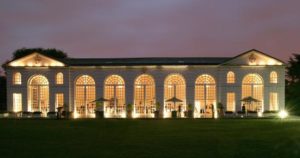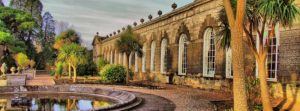Famous Orangeries in Britain
“Famous Orangery Landmarks in the UK”
Orangeries have been regarded as special and fashionable architectural structures since they were designed in the 17th century.
Perhaps you’ve had an orangery extension to your home, or are looking to invest in an orangery or period conservatory?
For inspiration (and a bit of fun!), let’s take a look at some of Britain’s most famous orangeries.
 |
 |
 |
Kedleston’s orangery

The orangery at the National Trust’s Kedleston is unusual in that instead of facing south like most orangeries (to make the most of the sunlight), it faces due east. It catches the sun first thing in the morning and then remains in the dark for the rest of the day. This is unusual for an orangery because they were originally meant to house exotic plants and therefore the more sunlight that falls on them, the better, so what happened here?
Well, the orangery was originally built facing south east. It even had an underground heating system and large windows to maximise the available light, with a large glazed roof installed at a later date.
But that orangery is long gone. The one that stands in the grounds of Kedleston today is a ghost of its former self. In the early 20th century, in an effort to formalise the grounds to match the status of the house, the orangery was relocated from its former south east facing position to its current easterly facing one.
What you see today is the remnants of the old orangery. The underground heating system wasn’t moved, the sloping roof wasn’t replaced and a lot of the original building was replaced with concrete after the transition.
So while this orangery isn’t particularly useful to house plants, it’s still an impressive building, made more so with its history, and well worth a look at for orangery design inspiration.
The Orangery at the Royal Botanic Gardens in Kew

The orangery at the Royal Botanical Gardens in Kew was built in 1761 and was designed by Sir William Chambers who was a Scottish-Swedish architect, based in London. It is built of brick and stucco. For those that are unsure, stucco is a type of cement plaster, made up of a binder and water.
The orangery was, at that time, the largest glasshouse in England. It was designed and built in order to grow citrus fruits, however, the low levels of light made the orangery unsuitable for this purpose.
See: The largest orangery in Europe
In 1841, the unhealthy orange trees were moved to the orangery at Kensington Palace and the orangery in Kew had large glazed doors installed at both ends so that it had higher lighting levels and, as a result, became more fit for purpose.
That said, in 1862-3, the orangery became a timber museum for exhibiting British wood, in 1989 it became a tearoom, and in 2002 it was repurposed once more, this time into its current form, a restaurant.
The Orangery at Margam Park

The orangery at Margam Park isn’t just a grand affair, it is one of the finest classical buildings in Wales, and at 327 feet in length, the longest orangery in Britain.
Built between 1778 and 1793 Thomas Mansel Talbot (the owner) commissioned architect Anthony Keck to design this dramatic and magnificent centerpiece to house his large collection of citrus trees – oranges, lemons and citrons. A striking orangery, classical composition but ornamental in detail, it required specialist craftsmen to construct it.
The orangery was lit by 27 tall windows and the building, while spacious, was of its time and therefore long and narrow to allow the sun streaming through the windows to penetrate the room, right to the back, even in winter.
The orangery required significant renovations in the 1970s to restore it to full grandeur, and allow it to be used once more. The renovations, while extensive, were sympathetic to the building’s original design and it was re-opened by Queen Elizabeth II in the year of her silver jubilee.
There is still a small collection of orange trees in the orangery at Margam Park today for visitors, but it is mainly used as a function room for events like wedding receptions and conferences.
Ham House and Garden Orangery

Ham House in Richmond upon Thames, owned by the National Trust, has a great example of a very early orangery – the building that is now the cafe.
The orangery at Ham House is a sizable building, apparently dating back to the 1670s and built to reflect Dutch classical architecture, with cross bar style windows that feature diamond shaped panes. The upper windows of the orangery are fixed, but the lower ones can be opened. If the orangery had been constructed later than it was, the windows are likely to have been sash windows, rather than cross bar, but they work in a very similar fashion.
While the orangery retains none of its original 17th century features, the only reflection of the old orangery is in the building’s architecture. 17th century orangeries were long, narrow buildings, heated originally by stoves, and this one is just that – long and narrow. Evidence that the building was in fact an orangery lies in the records that show the number of orange trees that were overwintered in the building following its construction.
The Orangery at Kensington Palace

The beautiful orangery at Kensington Palace is baroque in style, designed by Nicholas Hawksmoor, the clerk of works on Kensington Palace and was commissioned in 1704 by Queen Anne. She originally had the orangery built to protect her citrus trees from the harsh winter weather, but used it latterly for entertaining and hosting parties.
The orangery was renovated in the late 19th century when interior panelling was removed and 24 Corinthian columns and cornicing was installed to replace them.
Nowadays, the orangery at Kensington Palace is a restaurant and available to book for special occasions.
Orangery at Calke Abbey

The orangery at the ‘unstately’ home, Calke Abbey, was built in 1777 and the nine metre high, beautiful glass dome atop the building was added in 1836 to increase the amount of light that entered the building. Sadly the building, like the rest of the grounds, became dilapidated until the National Trust took it over in 1985.
They needed to carry out extensive repairs to the orangery to preserve it and make it safe for visitors, but to demonstrate the state that the property was taken over in, the paintwork and plaster has been left untouched, giving the orangery a neglected feel.
As you can see, orangeries have been a popular extension to properties since their inception in the 17th century. And for good reason.
Installing an orangery is a great way to maximise the amount of natural light that comes into your home, to seamlessly provide a transition between your home and garden and to give your family extra living space.
An orangery is a beautiful addition to both traditional and contemporary properties. Are you interested in having a hardwood orangery extension on your house?
Get in touch with our orangery design team today and we’ll work together to create you a bespoke orangery you’ll love.